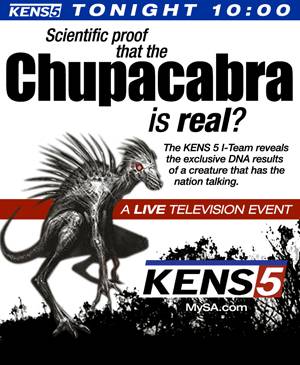Texas State researchers solve mystery of Cuero chupacabra
Posted by Jayme Blaschke
University News Service
November 1, 2007
 |
Biologists at Texas State University-San Marcos have succeeded in identifying the strange, hairless, doglike creature that gained fame throughout
Reality, it turns out, is far more mundane than the exotic origins one would expect for a supernatural creature: It’s a coyote.
“The DNA sequence is a virtually identical match to DNA from the coyote (Canis latrans),” said Mike Forstner of the biology department at
The odd-looking beast turned up this past summer on a ranch outside of the small town of
“Not often do we have genetic material available from an animal that has been linked to a legendary myth,” Forstner said. Normally, the only evidence available consists of blurry photographs, low-light video or other “untestable” pieces of evidence. This time, a south
“This is fun, not scary, but if people are worried about the chupacabra, it is probably even more important that we explain the mystery,” he said. “Folks can fear what they don’t understand, and a big part of the goal in science is to explain the natural world.”
Joe Conger of KENS 5 news provided a tissue sample from Canion’s preserved animal to
“DNA tells a story. It allows us to determine the difference between animal species, and while I thought it was a canid (one of the members in the dog family), I could not tell from the photographs which one it might be,” Forstner explained, pointing out that KENS 5 financed the testing. “From my perspective, we were interested in providing a direct answer from the DNA, testing the best guesses of experts by using the evidence from the animal itself.
“Jake extracted DNA from the sample, then we used PCR to generate template DNA and a Beckman Coulter Automated DNA sequencer to read that sequence,” he said. “We choose a part of the mitochondrial DNA genome that is very informative in mammals, called the D-Loop. Once we had the sequence, it was very easy to make an initial ‘match’ of the Cuero sample using the online genetic database, GENBANK. We also completed other analyses, but really, that first match told the tale.”
The main mystery might be solved, but the DNA match doesn’t explain the other looming question: Why does this coyote look so un-coyotelike?
“That is the best part about science--the first answers often lead to more questions and then better explanations of the world in which we live,” Forstner said. “We’ve taken additional skin samples and we will try to determine the cause of the hair loss.
“